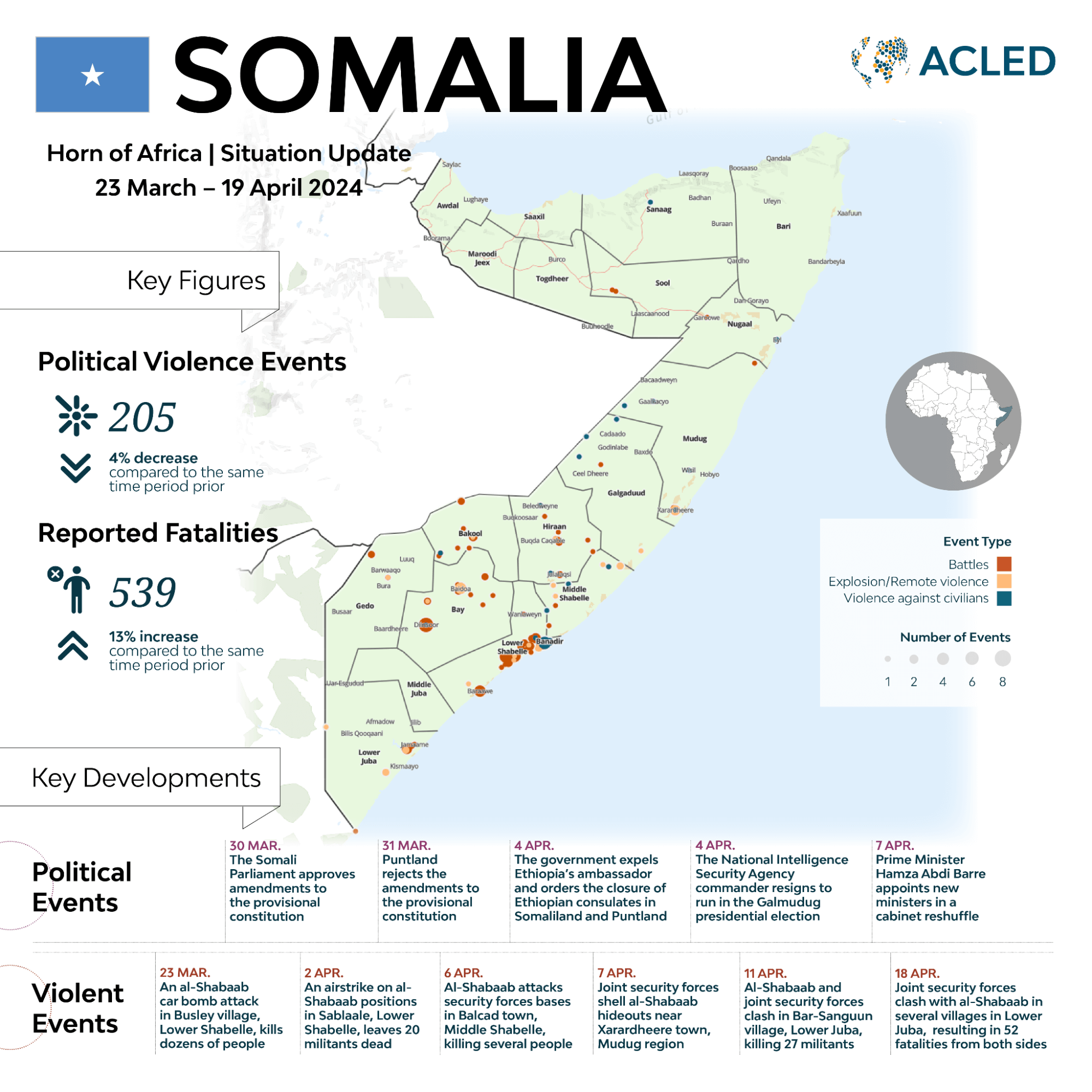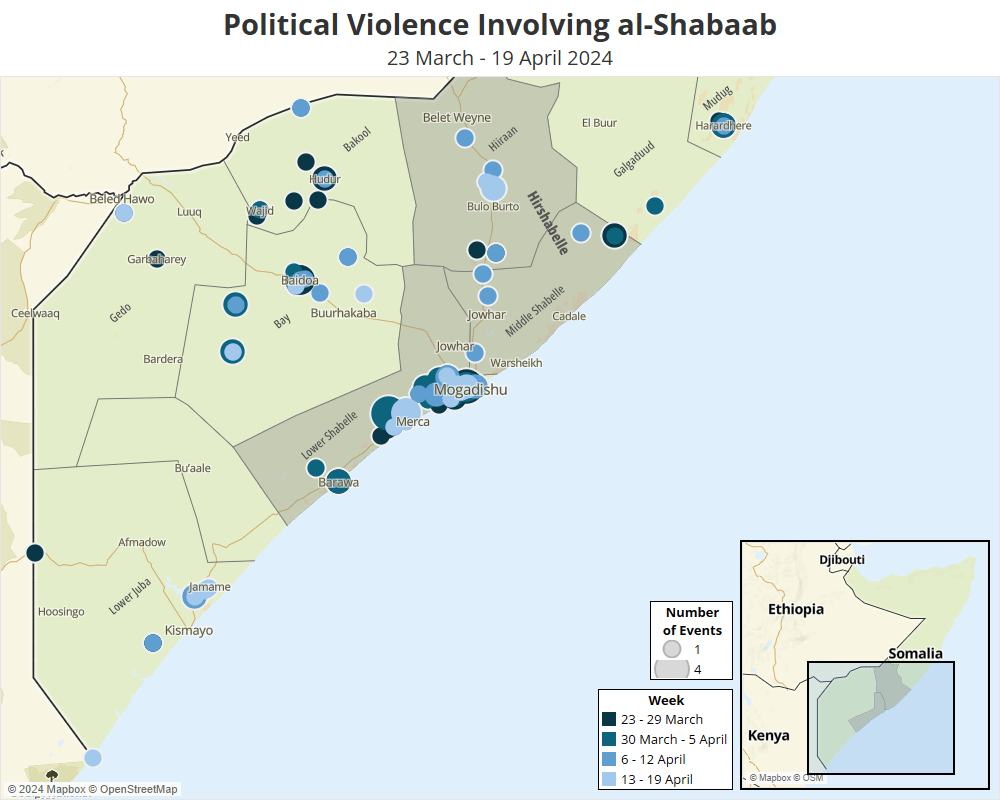Situation Update | April 2024
Somalia: Dispute Over Constitutional Amendment and Increased al-Shabaab Attacks
26 April 2024
Somalia at a Glance: 23 March to 19 April 2024
VITAL TRENDS
- ACLED records more than 205 political violence events and at least 539 reported fatalities from 23 March to 19 April. Most political violence centered in the Lower Shabelle region, where al-Shabaab increased attacks targeting security forces.
- Lower Shabelle region had the highest number of reported fatalities, with 117 recorded during the reporting period. Mudug region followed, with 114 reported fatalities. This is due to increased al-Shabaab attacks in Lower Shabelle and clashes between security forces and al-Shabaab militants in Mudug region.
- The most common event type was battles, with over 127 events, followed by explosions/remote violence, with 42 events. Most of these battles and explosions/remote violence events involved al-Shabaab.

Dispute Over Constitutional Amendment and Increased al-Shabaab Attacks
Somalia has used a provisional constitution since 2012, which the Federal Parliament initially hoped to finalize by 2016. The constitution was adopted as a provisional document by the National Constituent Assembly — composed of 825 representatives from various societies — because a referendum could not be held due to the security situation.1Constitution Net, ‘Constitutional history of Somalia,’ August 2018 After two previous federal administrations failed to finalize the constitution, the current Somali government kicked off the process to amend and formally approve it in May 2023.
This process led to the upper and lower houses of Parliament accepting the new amendments to the constitution with a majority vote on 30 March. The first round of new amendments focus on four out of 15 chapters of the constitution and includes measures to strengthen the role of the president, abolish the prime minister post and replace it with a vice president, and introduce universal suffrage in place of the clan-based indirect voting system.2Until now, there were no political parties in Somalia as the government was elected via an indirect clan-based voting system using a ‘4.5 power-sharing system.’ Under this system, the four main clans — Hawiye, Darod, Dir, and Rahanweyn — share the majority οf seats in Parliament, and the remaining 0.5 seats are shared by minority groups. The new amendments give power to the president to sack the prime minister before the role is replaced with a vice president in the next presidential election, whereas the provisional constitution gave this power to Parliament. The approved amendments also put in place direct voting for the federal president, vice president, and state leaders and extend the term of office of the federal president and Parliament from four to five years. These amendments, however, have been criticized, including by the Puntland administration and politicians representing other regions. Former presidents Mohamed Abdullahi Mohamed, also known as Farmajo, and Sharif Sheikh Ahmed warned about the changes in the provisional constitution affecting the clan-based power-sharing system, while two former prime ministers cited the lack of consultation and emphasized the need for a referendum to have widely agreed-upon changes.3Faisal Ali, ‘Somalia accused of ‘threatening national unity’ with new constitution, ‘ The Guardian, 5 April 2024; Harun Maruf, ‘Somalia’s Puntland region voices opposition to provisional constitution revisions,’ Voice of America,’ 31 March 2024; Hiiraan, ‘Over 70 Somali lawmakers oppose President’s Constitution amendment plans,’ 19 March 2024 Around 70 members of Parliament rejected the new amendments by arguing that the current amendment process is creating a new constitution rather than amending the provisional constitution.4Hirran, ‘Over 70 Somali lawmakers oppose President’s Constitution amendment plans,’ 19 March 2024; Abdirisaq Shino, ‘Over 70 Somali Legislators Unite Against President’s Unilateral Constitutional Plans,’ 20 March 2024
In the meantime, the counter-insurgency operation has continued in central Somalia. Notably, two al-Shabaab leaders were injured in a targeted airstrike on 2 April that also reportedly killed more than 20 militants.
Puntland Announces Independence from Somalia Amid Constitutional Amendment Dispute
The constitutional reform process has sparked new tensions between the federal government and the semi-autonomous Puntland administration.5Reuters, ‘Somalia’s Puntland refuses to recognise federal government after disputed constitutional changes,’ 31 March 2024 A day after the legislative body’s approval of the amendments, on 31 March, the Puntland administration announced itself as an independent government from Somalia by withdrawing from the federal system until the constitution is approved via a referendum.6Harun Maruf, ‘Somalia’s Puntland region voices opposition to provisional constitution revisions, ‘ Voice of America,’ 31 March 2024 Puntland’s information minister accused President Hassan Sheikh Mohamud of “gather[ing] authority into his hands.”7Faisal Ali, ‘Somalia accused of ‘threatening national unity’ with new constitution, ‘ The Guardian, 5 April 2024 This is the second time Puntland has cut ties with the current administration. In January 2023, the Puntland administration announced that it was acting independently from the federal government until the completion of the constitution via referendum.8Garowe Online, ‘Villa Somalia: Puntland in talks with Federal Government,’ 13 July 2023; Horn Observer, ‘Somalia’s Puntland State declares to act as an independent state,’ 11 January 2023
The dispute between Puntland and the federal government escalated when delegates from Puntland met with representatives of the Ethiopian Foreign Affairs Ministry in Addis Ababa, Ethiopia, on 3 April to discuss trade cooperation. This meeting was not coordinated with the federal government of Somalia9Garowe Online, ‘Puntland and Ethiopia Strengthen Ties Amid Regional Tensions,’ 7 April 2024 and came amid tension between Mogadishu and Addis Ababa over a memorandum of understanding signed between Somaliland and Ethiopia. This controversial MoU gives Ethiopia access to the Red Sea in exchange for officially recognizing Somaliland as a country. Following the recent meeting between Ethiopia and Puntland, the Somali government expelled the Ethiopian ambassador from Mogadishu, recalled its ambassador from Addis Ababa, and ordered the closure of the Ethiopian consulates in Somaliland and Puntland.10Falastine Iman and Mohamed Olad Hassan, ‘Somalia expels Ethiopian ambassador, orders closure of two consulates, ‘ Voice of America, 4 April 2024 The Somaliland and Puntland administrations rejected the federal government’s orders to close Ethiopia’s consulate in their respective capital towns.11Garowe Online, ‘We will not close Ethiopia’s consulate in Garowe, Puntland roars back, ‘ 5 April 2024; Brokena, ‘Puntland, Somaliland reject Mogadishu order to close Ethiopian consulate,’ 5 April 2024
The federal government is trying to address the grievances regarding the amendments to the constitution by engaging with all political stakeholders in the country and defusing tension with the Puntland administration. Hence, on 16 April, the government invited all state leaders for a meeting to discuss the amendments. However, the Puntland administration declined this invitation and indicated its intention to organize its own meeting to determine the future of federalism.12Garowe Online, “Puntland boycotts Hassan Sheikh’s meeting,’ 17 April 2024 Reportedly, Jubaland, Southwest, Galmudug, and Hirshabelle state leaders showed interest in attending the meeting organized by Puntland.13Garowe Online, “Puntland boycotts Hassan Sheikh’s meeting,’ 17 April 2024 If the dispute is not resolved soon, it might further affect the relationship between the federal government and the Puntland administration, involve other state administrations, and impact the federal system in the country.
Al-Shabaab’s Renewed Attacks Against Security Forces
Between 23 March and 19 April, al-Shabaab militants conducted several coordinated attacks against government security forces and the African Union Transition Mission in Somalia (ATMIS) forces. Amid a lull in government-backed operations due to factional divisions within the coalition (especially between the Hawadle and Abgal clans), al-Shabaab has increased its activity in Hirshabelle, particularly in areas along the Shabelle river, near the Cali Fool Dheere forest, and around the villages situated between Balcad and Mogadishu (see map below). Albeit at a slower pace, Somali security forces and allied clan militias carried out intermittent raids against al-Shabaab in the southern part of Mudug and Lower Shabelle regions. The latter has long been al-Shabaab’s operational center in central Somalia.
Government operations in the Lower Shabelle region in March and April targeted al-Shabaab hideout positions to flush out the militants along the main supply roads between Mogadishu and Lower Shabelle regions. These supply routes have been vital for al-Shabaab’s financial flows, as militants have enacted several strategic checkpoints to collect taxes from passenger vehicles and commercial trucks. To defend these checkpoints, al-Shabaab launched several attacks against security forces and their bases. For example, al-Shabaab runs a taxation checkpoint near Busley village to collect money from vehicles from Mogadishu. On 23 March, al-Shabaab detonated a suicide vehicle-borne IED targeting army troops at a base in Busley village, Lower Shabelle. The explosion was followed by an exchange of gunfire, leaving several soldiers dead and injured. Between 23 March and 19 April, ACLED records six remote explosions detonated by al-Shabaab targeting Somali security forces and 26 al-Shabaab attacks against security forces in Lower Shabelle. Al-Shabaab fighters also continued to launch attacks at ATMIS forces, most targeting the Ugandan forces operating bases and logistics convoys traveling along the main supply routes in Lower Shabelle.
In the Middle Shabelle and Hiiraan regions, al-Shabaab started regrouping and advancing toward government-controlled towns, including recapturing Daaru Nicma village in Middle Shabelle at the beginning of April. On 26 March, al-Shabaab launched an attack against security forces and allied clan militia at a base near Daaru Nicma village in Middle Shabelle. The militants overran the government forces and briefly took over the base. During the clashes, 67 people were reportedly killed from both sides, including a senior commander of the government forces. The militants also targeted ATMIS forces in this region, killing two Burundian soldiers in an IED attack in Buurane village.
Meanwhile, al-Shabaab leaders were reportedly injured in an airstrike by US forces, who are collaborating with the Somali National Army (SNA) in the counter-insurgency efforts, targeting key militant positions in Lower Shabelle. On 2 April, US forces and the SNA conducted an airstrike targeting an al-Shabaab safe house near Sablaale town in Lower Shabelle that killed more than 20 militants and injured 30 others, including two al-Shabaab leaders. The airstrike targeted al-Shabaab’s leader, Ahmed Diriye; his deputies, Mahad Warsame (also known as Mahad Karate) and Abu Akram; and the head of the political wing, Shaykh Hussein Fiidow.14Garowe Online, ‘Somalia: The leader of the AS group “survived” an airstrike, ‘ 2 April 2024 The al-Shabaab top leaders reportedly met in Lower Shabelle to resolve a dispute between the leader and his deputy, after two factions of al-Shabaab, one supporting Diriye or the other Karate, clashed on 9 March in the outskirts of Jilib town.
As a result of the slow pace of the government counter-insurgency operation, al-Shabaab militants had the opportunity to regroup and advance toward strategic areas between the capital, Mogadishu, and Balcad district in Middle Shabelle region, in Xawaadleey village. Notably, on 16 April, the militants were seen patrolling along the Balcad-Mogadishu road, which links the capital to the Middle Shabelle region. During these patrols, militants run several hideout checkpoints to collect taxes from passenger vehicles and commercial trucks and to monitor the security forces’ movements in certain areas. These two main supply routes from Mogadishu to Lower Shabelle and Middle Shabelle regions provide an advantage for al-Shabaab in their military operations and financial flows; as militants increase their presence in those areas, they pose a significant threat to security forces. These al-Shabaab movements come amid a drop in the government counter-insurgency operations and thus heighten the risk of the militants regaining control of previously lost territories.





